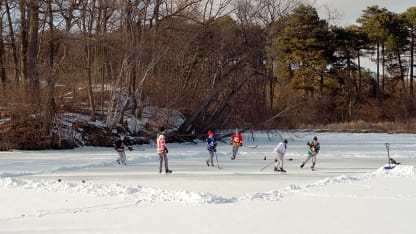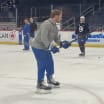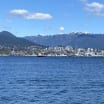As part of the NHL Green initiative celebrating Green Month in April, NHL.com will feature stories on how the NHL is looking to grow and protect the game of hockey and its communities for generations to come. Today, Robert McLeman from Wilfrid Laurier University and the RinkWatch Project, writes about the importance of outdoor rinks during the COVID-19 pandemic. NHL Green and RinkWatch have been working together since 2016 with a common of goal of our protecting our game and planet for future generations.
Outdoor skating on the rise during pandemic, RinkWatch says
NHL Green partner using data to track climate change

By
Robert McLeman / Special to NHL.com
Outdoor skating has always been an important pastime in the colder parts of North America, but never more so than this past winter. With arenas, sports facilities, and schools being closed in many communities because of COVID-19, outdoor skating rinks were among the few places people could gather for safe, socially-distanced activity. Fortunately, the weather cooperated, with most regions across North America experiencing uninterrupted cold temperatures through the heart of winter.
At RinkWatch, we have been monitoring outdoor skating since 2013 with the help of a network of volunteer citizen scientists who submit daily reports on rink conditions. We use this data to understand key temperature thresholds for building and maintaining outdoor rinks and to build computer models to study how climate change is affecting outdoor skating. Recent winters have seen temperatures yo-yo from one year to the next, some bringing polar vortex extreme cold, while others have seen record mild temperatures in many locations. The last pre-pandemic winter (2019-20) was especially mild in eastern North America, and many normally reliable rinks and ponds were never skateable. This past October was frigid in western Canada and the northern U.S. Great Plains, and outdoor rinks had their earliest start in years. Skaters in the East had to wait until Christmas for cold temperatures, which then lasted through early March. The lack of mid-winter warm spells made for an especially good skating season.
Community skating rinks were busy like never before. Aric Dodd, a RinkWatch participant from Saskatoon told us, "We were so busy in November and December, hockey players and skaters of all ages were eager to get outside and get some exercise with friends and family in a safe manner." It was the same story in Richard's Landing, Ontario, where long time community rink manager Carole Hunt-Ford saw a notable increase in the number of young families skating together. In Bozeman, Montana, local rink manager Thom White said there were no gently used skates to be found anywhere in town.
NHL fans know Brantford, Ontario as the town where Walter Gretzky built a backyard rink for his son, Wayne. Walter died on March 4, causing an outpouring of grief in Canada, where he was the country's unofficial hockey dad, lending his time and energy to charities and events too numerous to list here. This winter, usage was at an all-time high on the 15 outdoor rinks maintained by volunteers in local parks, according to coordinator Lori-Dawn Cavin. A perfect tribute to Walter.
The pandemic saw many people build backyard rinks for the first time. John Greco moderates a Facebook group for outdoor rink-making enthusiasts and saw a tremendous surge in new users seeking advice: "Our membership jumped from 10,000 in January 2020 to over 23,000 by January 2021, most of them first-time rink builders." It was a similar story on another Facebook group for rink makers, moderated by David Bird: "Membership in our group almost doubled. With indoor rinks shut down, a whole new group of people were exposed to outdoor skating. Backyard rinks are the true history of the game, and COVID-19 has in its way introduced a whole new generation to hockey's roots". Will one of these new backyard rinks produce another Gretzky? Let's hope. Waterloo, Ontario minor hockey coach Ian Williams said, "on outdoor rinks, kids develop a higher level of creativity, and attempt things they wouldn't try in an organized game".
RinkWatch also benefited from renewed interest in outdoor rinks. We saw a doubling in the number of volunteers this winter for our Sentinels program, where rink-makers work with a research assistant to record especially detailed data about their rinks. Data like these have helped us document how temperatures are becoming less reliable for outdoor rink-making in the Original Six NHL cities, and how coming decades will see greater challenges as temperatures warm. Outdoor rinks were a silver lining in the cloud that is COVID-19 that we hope will flourish for many winters to come.

















